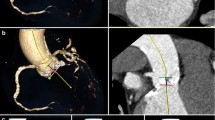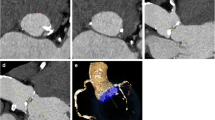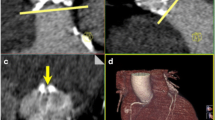Abstract
Objectives
Transcatheter Aortic Valve Implantation (TAVI) is an alternative to surgical valve replacement in high risk patients. Angiography of the aortic root, aorta and iliac arteries is required to select suitable candidates, but contrast agents can be harmful due to impaired renal function. We evaluated ECG-triggered high-pitch spiral dual source Computed Tomography (CT) with minimized volume of contrast agent to assess aortic root anatomy and vascular access.
Methods
42 patients (82 ± 6 years) scheduled for TAVI underwent dual source (DS) CT angiography (CTA) of the aorta using a prospectively ECG-triggered high-pitch spiral mode (pitch = 3.4) with 40 mL iodinated contrast agent. We analyzed aortic root/iliac dimensions, attenuation, contrast to noise ratio (CNR), image noise and radiation exposure.
Results
Aortic root/iliac dimensions and distance of coronary ostia from the annulus could be determined in all cases. Mean aortic and iliac artery attenuation was 320 ± 70 HU and 340 ± 77 HU. Aortic/iliac CNR was 21.7 ± 6.8 HU and 14.5 ± 5.4 HU using 100 kV (18.8 ± 4.1 HU and 8.7 ± 2.6 HU using 120 kV). Mean effective dose was 4.5 ± 1.2 mSv.
Conclusions
High-pitch spiral DSCTA can be used to assess the entire aorta and iliac arteries in TAVI candidates with a low volume of contrast agent while preserving diagnostic image quality.
Key Points
• Transcatheter Aortic Valve Implantation (TAVI) offers an alternative to surgical valve replacement in high risk patients.
• Such procedures require essential information about aortic root anatomy and vascular access.
• High pitch ECG-triggered dual source Computed Tomography (CT) can provide this information
• Sufficient image quality can be maintained even with low volumes of contrast agent and reduced x-ray exposure.





Similar content being viewed by others
References
Iung B, Baron G, Butchart EG, Delahaye F, Gohlke-Bärwolf C et al (2003) A prospective survey of patients with valvular heart disease in Europe: the euro heart survey on valvular heart disease. Eur Heart J 24:1231–1243
Iung B, Baron G, Tornos P, Gohlke-Bärwolf C, Butchart EG et al (2007) Valvular heart disease in the community: a European experience. Curr Probl Cardiol 32:609–661
Cribier A, Eltchaninoff H, Bash A, Borenstein N, Tron C et al (2002) Percutaneous transcatheter implantation of an aortic valve prosthesis for calcific aortic stenosis: first human case description. Circulation 106:3006–3008
Cribier A, Eltchaninoff H, Tron C, Bauer F, Agatiello C et al (2006) Treatment of calcific aortic stenosis with the percutaneous heart valve: mid-term follow-up from the initial feasibility studies: the French experience. J Am Coll Cardiol 47:1214–1223
Cribier A, Eltchaninoff H, Tron C, Bauer F, Agatiello C et al (2004) Early experience with percutaneous transcatheter implantation of heart valve prosthesis for the treatment of end-stage inoperable patients with calcific aortic stenosis. J Am Coll Cardiol 43:698–703
Descoutures F, Himbert D, Lepage L, Iung B, Détaint D et al (2008) Contemporary surgical or percutaneous management of severe aortic stenosis in the elderly. Eur Heart J 29:1410–1417
Webb JG, Chandavimol M, Thompson CR, Ricci DR, Carere RG et al (2006) Percutaneous aortic valve implantation retrograde from the femoral artery. Circulation 113:842–850
Leon MB, Smith CR, Mack M, Miller DC, Moses JW, PARTNER Trial Investigators et al (2010) Transcatheter aortic-valve implantation for aortic stenosis in patients who cannot undergo surgery. N Engl J Med 363:1597–1607
Tops LF, Wood DA, Delgado V, Schuijf JD, Mayo JR et al (2008) Noninvasive evaluation of the aortic root with multislice computed tomography implications for transcatheter aortic valve replacement. JACC Cardiovasc Imaging 1:321–330
Vahanian A, Alfieri O, Al-Attar N, Antunes M, Bax J et al (2008) Transcatheter valve implantation for patients with aortic stenosis: a position statement from the European association of cardio-thoracic surgery (EACTS) and the European Society of Cardiology (ESC), in collaboration with the European Association of Percutaneous Cardiovascular Interventions (EAPCI). EuroIntervention 4:193–199
Moss RR, Ivens E, Pasupati S, Humphries K, Thompson CR et al (2008) Role of echocardiography in percutaneous aortic valve implantation. JACC Cardiovasc Imaging 1:15–24
Messika-Zeitoun D, Serfaty JM, Brochet E, Ducrocq G, Lepage L et al (2010) Multimodal assessment of the aortic annulus diameter: implications for transcatheter aortic valve implantation. J Am Coll Cardiol 55:186–194
Wood DA, Tops LF, Mayo JR, Pasupati S, Schalij MJ et al (2009) Role of multislice computed tomography in transcatheter aortic valve replacement. Am J Cardiol 103:1295–1301
Goffinet C, Kersten V, Pouleur AC, le Polain de Waroux JB, Vancraeynest D et al (2010) Comprehensive assessment of the severity and mechanism of aortic regurgitation using multidetector CT and MR. Eur Radiol 20:326–336
Stolzmann P, Knight J, Desbiolles L, Maier W, Scheffel H et al (2009) Remodelling of the aortic root in severe tricuspid aortic stenosis: implications for transcatheter aortic valve implantation. Eur Radiol 19:1316–1323
Karlo C, Leschka S, Goetti RP, Feuchtner G, Desbiolles L et al (2011) High-pitch dual-source CT angiography of the aortic valve-aortic root complex without ECG-synchronization. Eur Radiol 21:205–212
Petersilka M, Bruder H, Krauss B, Stierstorfer K, Flohr TG (2008) Technical principles of dual source CT. Eur J Radiol 68:362–368
Achenbach S, Giesler T, Ropers D, Ulzheimer S, Anders K et al (2003) Comparison of image quality in contrast-enhanced coronary-artery visualization by electron beam tomography and retrospectively electrocardiogram-gated multislice spiral computed tomography. Invest Radiol 38:119–128
Macari M, Chandarana H, Schmidt B, Lee J, Lamparello P et al (2006) Abdominal aortic aneurysm: can the arterial phase at CT evaluation after endovascular repair be eliminated to reduce radiation dose? Radiology 241:908–914
Mangano CM, Diamondstone LS, Ramsay JG, Aggarwal A, Herskowitz A et al (1998) Renal dysfunction after myocardial revascularization: risk factors, adverse outcomes, and hospital resource utilization. The Multicenter Study of Perioperative Ischemia Research Group. Ann Intern Med 128:194–203
Antunes PE, Prieto D, Ferrao de Oliveira J, Antunes MJ (2004) Renal dysfunction after myocardial revascularization. Eur J Cardiothorac Surg 25:597–604
Chertow GM, Lazarus JM, Christiansen CL, Cook EF, Hammermeister KE et al (1997) Preoperative renal risk stratification. Circulation 95:878–884
Leipsic J, Wood D, Manders D, Nietlispach F, Masson JB et al (2009) The evolving role of MDCT in transcatheter aortic valve replacement: a radiologists’ perspective. AJR Am J Roentgenol 193:W214–W219
Blanke P, Euringer W, Baumann T, Reinöhl J, Schlensak C et al (2010) Combined assessment of aortic root anatomy and aortoiliac vasculature with dual-source CT as a screening tool in patients evaluated for transcatheter aortic valve implantation. AJR Am J Roentgenol 195:872–881
Nietlispach F, Leipsic J, Al-Bugami S, Masson JB, Carere RG et al (2009) CT of the ilio-femoral arteries using direct aortic contrast injection: proof of feasibility in patients screened towards percutaneous aortic valve replacement. Swiss Med Wkly 139:458–462
Ben-Dor I, Waksman R, Hanna NN, Raizon A, Satler LF et al (2010) Utility of radiologic review for noncardiac findings on multislice computed tomography in patients with severe aortic stenosis evaluated for transcatheter aortic valve implantation. Am J Cardiol 105:1461–1464
Weisbord SD, Palevsky PM (2010) Strategies for the prevention of contrast-induced acute kidney injury. Curr Opin Nephrol Hypertens 19:539–549
Goetti R, Baumüller S, Feuchtner G, Stolzmann P, Karlo C et al (2010) High-pitch dual-source CT angiography of the thoracic and abdominal aorta: is simultaneous coronary artery assessment possible? AJR Am J Roentgenol 194:938–944
Leber AW, Knez A, Becker C, Becker A, White C et al (2003) Non-invasive intravenous coronary angiography using electron beam tomography and multislice computed tomography. Heart 89:633–639
Karaca M, Kirilmaz A, Oncel G, Oncel D, Yilmaz H et al (2007) Contrast-enhanced 64-slice computed tomography in detection and evaluation of anomalous coronary arteries. Tohoku J Exp Med 213:249–259
Holmquist F, Hansson K, Pasquariello F, Bjork J, Nyman U (2009) Minimizing contrast medium doses to diagnose pulmonary embolism with 80-kVp multidetector computed tomography in azotemic patients. Acta Radiol 50:181–193
Shiran A, Adawi S, Ganaeem M, Asmer E (2009) Accuracy and reproducibility of left ventricular outflow tract diameter measurement using transthoracic when compared with transesophageal echocardiography in systole and diastole. Eur J Echocardiogr 10:319–324
Lu TL, Huber CH, Rizzo E, Dehmeshki J, von Segesser LK et al (2009) Ascending aorta measurements as assessed by ECG-gated multi-detector computed tomography: a pilot study to establish normative values for transcatheter therapies. Eur Radiol 19:664–669
Acknowledgements
Prof. Achenbach received research grants from Siemens and Bayer, Speaker Honoraria by Siemens and works as a Consultant for Siemens.
Author information
Authors and Affiliations
Corresponding author
Rights and permissions
About this article
Cite this article
Wuest, W., Anders, K., Schuhbaeck, A. et al. Dual source multidetector CT-angiography before Transcatheter Aortic Valve Implantation (TAVI) using a high-pitch spiral acquisition mode. Eur Radiol 22, 51–58 (2012). https://doi.org/10.1007/s00330-011-2233-0
Received:
Revised:
Accepted:
Published:
Issue Date:
DOI: https://doi.org/10.1007/s00330-011-2233-0




